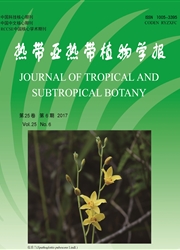

 中文摘要:
中文摘要:
为了解荷木对土壤水分利用的干湿季差异,利用热消散探针法(TDP)连续监测荷木(Schimasuperba)液流密度(Js),基于测定的叶片水势(ΨL)、叶面积指数(LAI)及胡伯尔值(AS∶AL)等参数,结合同步监测的环境因子,分析整树水力导度(KL)、冠层气孔导度(GS)和蒸腾有效储存水量(Q)的干湿季变化。结果表明,干季荷木林出现土壤水分亏缺,使荷木对水分吸收和传输的阻力增加。但GS对水汽压亏缺(VPD)的敏感性较高,使干湿季正午叶片水势(ΨL-mid)、土壤-叶片水势差(ΔΨS-L)保持相对稳定;干季荷木通过降低LAI、KL和GS有效调控蒸腾;增加Q对日蒸腾的贡献率及单位叶面积的Q以部分补偿水分胁迫。这些适应性调节使荷木在光热资源仍然充足的干季保持旺盛的蒸腾活动,维持与湿季相似的单位叶面积蒸腾量。因此,KL和GS的调节作用、Q的水力补偿效应以及自身水力特征在一定程度上解释了荷木干湿季单位叶面积的水分利用呈常数状态,并且SWC对蒸腾无明显的限制作用的原因。
 英文摘要:
英文摘要:
In order to understand the difference in soil water use of Schima superba in dry and wet seasons,the sap flux densities(Js)of S.superba were continually monitored using Granier’s thermal dissipation probes(TDP).Based on the measurements of leaf water potential(ΨL),parameters of hydraulic structures,such as leaf area index(LAI),and Huber value(AS∶AL),in combination of the synchronized monitoring environment factors,the dry/wet seasonal changes in whole-tree hydraulic conductance(KL),canopy stomatal conductance(GS)and effective water storage for transpiration(Q)of S.superba were analyzed.The results showed that the soil water deficit in the dry season increased the resistance of water absorption and transpiration of S.superba.However,theGS of S.superba was sensitive to the vapor pressure deficit(VPD)to keep midday leaf water potential(ΨL-mid),water potential gradient between leaves and the soil(ΔΨS-L)in dry and wet seasons.Moreover,the LAI、KL and GSof S.superba decreased to effectively regulate transpiration in the dry season.Meanwhile,the high contribution of effective water storage for transpiration(Q)to daily transpiration and Q per unit leaf area in the dry season would partially compensate the water stress.Since the S.superba plantation could maintain a vigorous transpiration with those adaptive regulations in the dry season during which it still had sufficient solar and thermal resources in south China,the whole-tree water use per unit leaf area of S.superba in the dry seasons was kept similar to that in wet seasons.Therefore,it was suggested that the regulating of KL and GS,the hydraulic compensation effect of Q,and the hydraulic characteristics,could to some extent explain that the whole-tree water use per unit leaf area of S.superba remained constant in the dry and wet seasons,and SWC had no significant effect on transpiration.
 同期刊论文项目
同期刊论文项目
 同项目期刊论文
同项目期刊论文
 期刊信息
期刊信息
